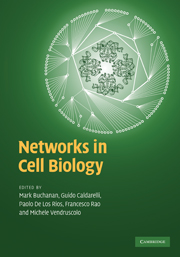Book contents
- Frontmatter
- Contents
- List of contributors
- Introduction
- 1 Network views of the cell
- 2 Transcriptional regulatory networks
- 3 Transcription factors and gene regulatory networks
- 4 Experimental methods for protein interaction identification
- 5 Modeling protein interaction networks
- 6 Dynamics and evolution of metabolic networks
- 7 Hierarchical modularity in biological networks: the case of metabolic networks
- 8 Signalling networks
- Appendix A Complex networks: from local to global properties
- Appendix B Modelling the local structure of networks
- Appendix C Higher-order topological properties
- Appendix D Elementary mathematical concepts
- References
- Index
1 - Network views of the cell
Published online by Cambridge University Press: 05 June 2012
- Frontmatter
- Contents
- List of contributors
- Introduction
- 1 Network views of the cell
- 2 Transcriptional regulatory networks
- 3 Transcription factors and gene regulatory networks
- 4 Experimental methods for protein interaction identification
- 5 Modeling protein interaction networks
- 6 Dynamics and evolution of metabolic networks
- 7 Hierarchical modularity in biological networks: the case of metabolic networks
- 8 Signalling networks
- Appendix A Complex networks: from local to global properties
- Appendix B Modelling the local structure of networks
- Appendix C Higher-order topological properties
- Appendix D Elementary mathematical concepts
- References
- Index
Summary
The network hypothesis
A cell is an enormously complex entity made up by myriad interacting molecular components that perform the biochemical reactions that maintain life. This book is about the network hypothesis, according to which it is possible to describe a cell through the set of interconnections between its component molecules. Hence, it becomes convenient to focus on these interactions rather than on the molecules themselves to describe the functioning of the cell.
The central dogma in molecular biology describes the way in which a cell processes the information required to produce the molecules necessary to sustain its existence and reproduction. It is also becoming increasingly clear, however, that in order to establish a more complete description of the manner in which a cell works we require a deeper understanding of the manner in which the sets of interconnections between these molecules are defining the identity of the cell itself. It is therefore important to investigate whether the genetic makeup of an organism does not only specify the rules for generating proteins, but also the way in which these proteins interact among themselves and with the other molecules in a cell.
Complex networks Networks are a way to represent an ensemble of objects together with their relations. Objects are described by means of vertices (sometimes also called nodes) and their relations by edges (sometimes also called links or connections) connecting them, which can be weighted to reflect their strength. […]
- Type
- Chapter
- Information
- Networks in Cell Biology , pp. 4 - 13Publisher: Cambridge University PressPrint publication year: 2010



